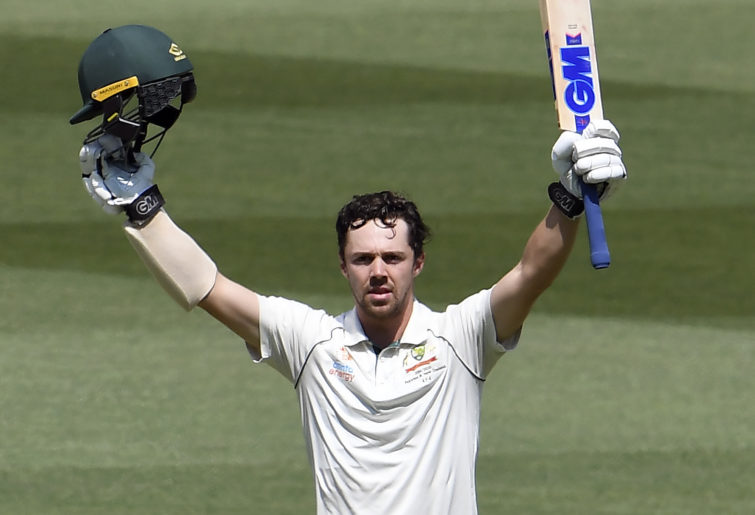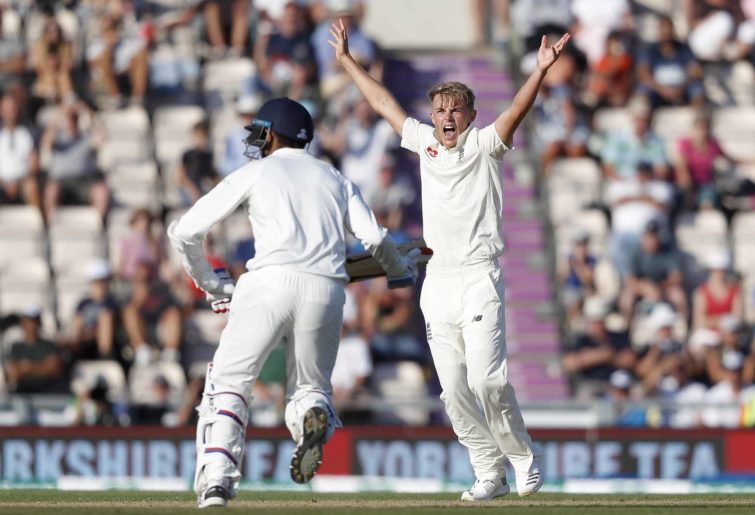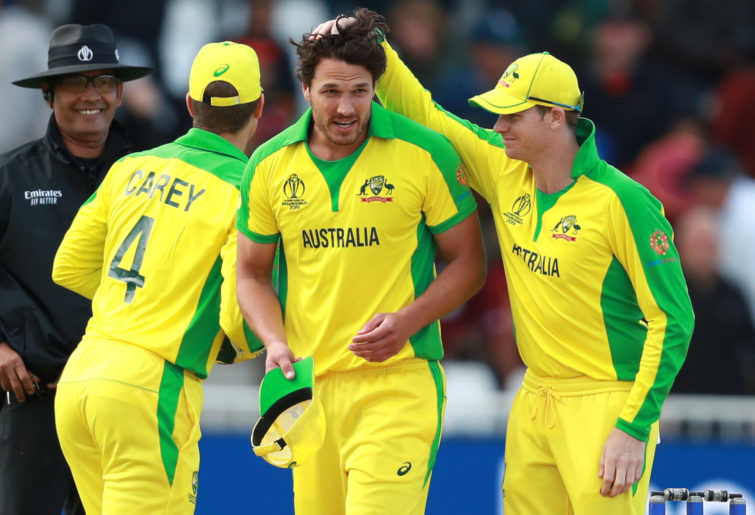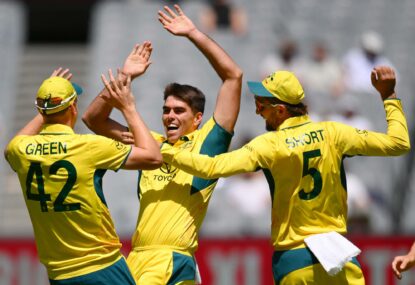The following criteria was used to come up with my emerging Test and ODI XI of the decade.
Debuted between 2017-2019
Played a minimum of five Test matches between 2017-2019 (for the Test XI)
Played a minimum of ten ODI matches between 2017-2019 (for the ODI XI)
My emerging Test XI of the decade
1. Aiden Markram (captain) – 1424 Test runs, 38.49 average, four centuries
Markram had an excellent start to his Test career with four centuries to his name within his first year of Test cricket.
The right-hander has been outstanding in South African conditions, averaging 46.21 including two quality hundreds against Australia.
Although he has had his weaknesses on the subcontinent, I expect him to become a much better player of spin as his career goes on. He is the captain of this side due to captaining his country at under-19 level and in one-day internationals.
2. Mayank Agarwal – 974 Test runs, 57.29 average, three centuries
Making his debut at the MCG after being called up halfway through the series against Australia, Agarwal has been almost flawless in his Test career. Despite scoring two high-class double tons, my favourite hundred from him was his 108 vs South Africa in Pune.
The ball was moving around and against Kagiso Rabada, Vernon Philander and Anrich Nortje, Agarwal hung on and batted exceptionally well to score his second Test ton.
Despite not performing to his standards in New Zealand, he will be a successful Test opener if he sticks to the basic principles of Test cricket.
3. Marnus Labuschagne – 1459 Test runs, 63.43 average, four hundreds
Loose bus change. He had a pretty bang average start to his Test career with only one half-century in nine innings. But some quality performances in county cricket and some help from Jofra Archer had given Labuschagne another chance to crack it in Test cricket.

“Everything the light touches is yours”. (AP Photo/Matt Dunham)
And boy did he take the opportunity. Since he came out as a concussion substitute at Lord’s, Labuschagne has averaged 83.26 in Test cricket. He will have downs in his career, but he has cemented that number three spot for Australia for the long term with ease.
4. Hanuma Vihari – 552 Test runs, 36.8 average, one hundred
Vihari has the third-highest first-class average among active players but hasn’t translated that into Test cricket just yet.
A half-century on debut in England showed that he was ready at the highest level. Vihari is a team player and has done the job of blunting the new ball when he was promoted as an opener in Australia for the boxing day Test.
He is a similar player to Cheteshwar Pujara and will be a successful player for India in the future if given proper chances to cement his spot. Bowls some decent off-spinners and has taken wickets when given the ball in hand.
5. Travis Head – 1091 Test runs, 41.96 average, two hundreds
Head hasn’t set the world on fire, but he’s played some crucial knocks for Australia when donning the whites. On debut, he scored a vital 72 to help Australia save a Test match versus Pakistan in the UAE. In Australian conditions, Head has passed fifty quite often but has thrown his wicket away after reaching the landmark.
A century at the MCG versus New Zealand showed that he is still good enough at this level, but he’ll need to keep the consistency away from home to keep his spot in the Australian XI.

(William West/AFP/Getty Images)
6. Rishabh Pant – 814 Test runs, 38.76 average, two hundreds
An exciting young prospect for India. Thrown into the deep end halfway through India’s tour of England, Pant has been solid with the bat for India. He’s the only Indian wicketkeeper to score a Test hundred in England and India. He can change the momentum of a game in the lower order like Adam Gilchrist, but he only plays Tests for India outside the subcontinent nowadays. This can harm his performances for India if he’s not given proper chances to play Test cricket in all conditions.
7. Ben Foakes (keeper) – 332 Test runs, 41.5 average, one hundred
How he got dropped from England’s Test team baffles me – he’s by far the best gloveman in England. He’s a very handy batsman to have at number seven with a solid defence and the ability to stop a whole batting collapse as shown with his maiden century on debut versus Sri Lanka.
8. Sam Curran – 37 Test wickets, 31.7 average, 3.26 economy
The left-armer has been very good for England since his debut. He doesn’t bowl quick, but his ability to swing it back in against right-handed batsmen and the natural angle that left-arm seamers have has seen him bag crucial wickets.
A very handy bowling all-rounder, scoring runs in low scoring thrillers leading to victories for England.

(AP Photo/Alastair Grant)
9. Kuldeep Yadav – 24 Test wickets, 24.13 average, 3.51 economy
Choosing the lone spinner was so difficult as I had Jack Leach and Ajaz Patel in mind as well. But Kuldeep has a better bowling average than the other two and has a five-wicket haul outside of the subcontinent. The left-arm left-arm wrist spinner has had sporadic opportunities to shine in Test cricket due to competing against Ravindra Jadeja and Ravichandran Ashwin, but he’s shined when given the opportunities.
On a Dharamsala pitch with not much turn, Yadav took a four-fer on debut to spin India to victory against Australia. He’s a handy lower-order batsman to have in the team with a first-class century to his name.
10. Mohammad Abbas – 75 Test wickets, 20.76 average, 2.45 economy
What a find for Pakistan cricket. Abbas is deadly accurate, bowling to similar speeds of South African great Vernon Philander.
He has taken scalps on dead pitches in the UAE and won Pakistan a Test versus England at Lord’s in 2018. He would be my new ball bowler, and I’d back him to take wickets irrespective of the conditions
11. Jasprit Bumrah – 68 Test wickets, 20.34 average, 2.69 economy
In his first tours of England, Australia and South Africa, Bumrah took a fifer in each of those nations. With his awkward actions and express pace, he has been a spectacular find for Indian cricket. In just 14 Tests, the right arm speedster has bagged five 5-fers without playing a single Test in India.
He did struggle a bit in New Zealand in his first few spells after a long-term injury, but he bounced back very well. In this team, he’d partner Abbas, and I’d back him to dismiss batsmen with his pace and variations.
My emerging ODI XI of the decade
1. Imam Ul-Haq – 1723 ODI runs, 53.84 average, seven hundreds
Imam Ul-Haq gets so much unfair criticism since his uncle is the legendary Inzamam Ul-Haq and is on the selection panel. The left-hander made a century on debut and hasn’t looked back since. His strike rate is on the slower side, but he allows other batsmen to play more freely and bat around him.
2. Alex Carey (wk) – 884 ODI runs, 34 average, four fifties
Carey has been brilliant for Australia in 50 over cricket since his debut at the Gabba two years ago. He’s played the accumulator and finisher role very well between number five to number seven. With a lack of openers in the XI and having opened for South Australia and Adelaide Strikers many times, I’m putting Carey in to face the new cherry with Imam.

(Photo by David Rogers/Getty Images)
3. Rassie Van Der Dussen – 707 ODI runs, 70.7 average, seven fifties
It’s so surprising that a player of his quality and calibre debuted at the age of 29. Since he’s come into the South African setup, he has been world-class. In the World Cup, he was by far their best batsman, and he’s still got another 6-7 years to serve South African cricket.
4. Shreyas Iyer (captain) – 748 ODI runs, 49.87 average, one hundred
How he was dropped from the Indian ODI side in 2018 was questionable. He was the in-form man for India in domestic cricket leading up to the World Cup, yet he didn’t make the squad.
Since then, Iyer has been brilliant for India batting at no.4 and will be batting for India at four during the 2023 World Cup. My captain for this team as he captains Mumbai in List A level and Delhi Capitals in the IPL.
5. Nicholas Pooran – 932 ODI runs, 49.05 average, one hundred
I was surprised to see him play one-day cricket considering he made a name for himself through T20 leagues. He plays pace and spin so well and has been quality since his debut 15 months ago. He has many years left in him and will end up as successful as AB De Villiers in ODI’s, in my opinion.
6. Mohammad Saifuddin – 290 ODI runs, 32.22 average, two fifties, 31 ODI wickets, 31.35 average, 5.87 economy
After many years, Bangladesh has finally found a seam-bowling all-rounder. Saifuddin has been brilliant for Bangladesh with the ball, taking wickets in middle and death overs but he does go for a few runs as shown in his economy.
The all-rounder is regarded as a big hitter in domestic cricket and has translated that into the international arena. I genuinely believe he can be Bangladesh’s Ben Stokes if he’s given the chances to bat in the top six consistently for Bangladesh.
He can inspire the younger generations to become seam-bowling all-rounder, but a back problem for the last nine years could potentially derail/prematurely end his career. In this side, I’m having him play as a finisher and a fourth seamer.
7. Shahdab Khan – 491 ODI runs, 25.92 average, three fifties, 59 ODI wickets, 29.66 average, 5.02 economy
Khan was still a teenager when he was part of the Pakistan squad that won the Champions Trophy. A big turner of the ball, he has been Sarfraz Ahmed’s go-to man to take wickets in the middle overs. But don’t underestimate his batting ability.
He had played helpful cameos and useful fifties for Pakistan when he was required to step up with the bat. Alongside Saifuddin, I would have Khan as a finisher as well; however, if there were an early collapse, Khan would come ahead of Saifuddin to steady the ship.
8. Jofra Archer – 23 ODI wickets, 24.73 average, 4.63 economy
He was the X-factor England needed to win the World Cup and boy did he deliver. He doesn’t have anything funky in his run-up. Just run in and bowl fast and accurate.
Deadly slower ball, yorker and bouncer. He already is a world-class white-ball bowler, and as long as England manage him properly, he will end up as England’s greatest white-ball bowler. Can hit the ball pretty far too if he’s needed to smack a few at the death.

(Gareth Copley/Getty Images)
9. Kuldeep Yadav – 104 ODI wickets, 26.16, 5.11 economy
There’s just something about left-arm left-arm wrist spinner bowlers that keeps me hooked onto the telly. I saw Brad Hogg bowl in the latter stages of his career, and while Kuldeep isn’t at his level, he has a lot of potential. He’s not afraid to toss it up even after being hit for a boundary, and this attacking mindset has paid off many times for him and India.
He has quite a few variations which have bamboozled many batsmen. The real Test will come when his variations are easier to pick by batsmen and how he responds to that. He and Shahdab Khan would have a field day if they were to bowl in tandem on a pitch with just a hint of turn
10. Lungi Ngidi – 53 ODI wickets, 21.5 average, 5.56 economy
Another promising player on South Africa’s list of young fast bowlers. He doesn’t bowl express pace, but his hit the deck style alongside his height has surprised opposition batsmen many times. Would be my first change bowler with the responsibility to take wickets in the middle overs.
11. Shaheen Shah Afridi – 40 ODI wickets, 21.17 average, 5.50 economy
What is it with Pakistan and producing an endless list of left-arm seamers? Since making his ODI debut in the 2018 Asia Cup, he’s been Pakistan’s best bowler in one day cricket by a mile. At just the age of 20, Afridi has many years of cricket left in him to make a serious impact on world cricket









































































































